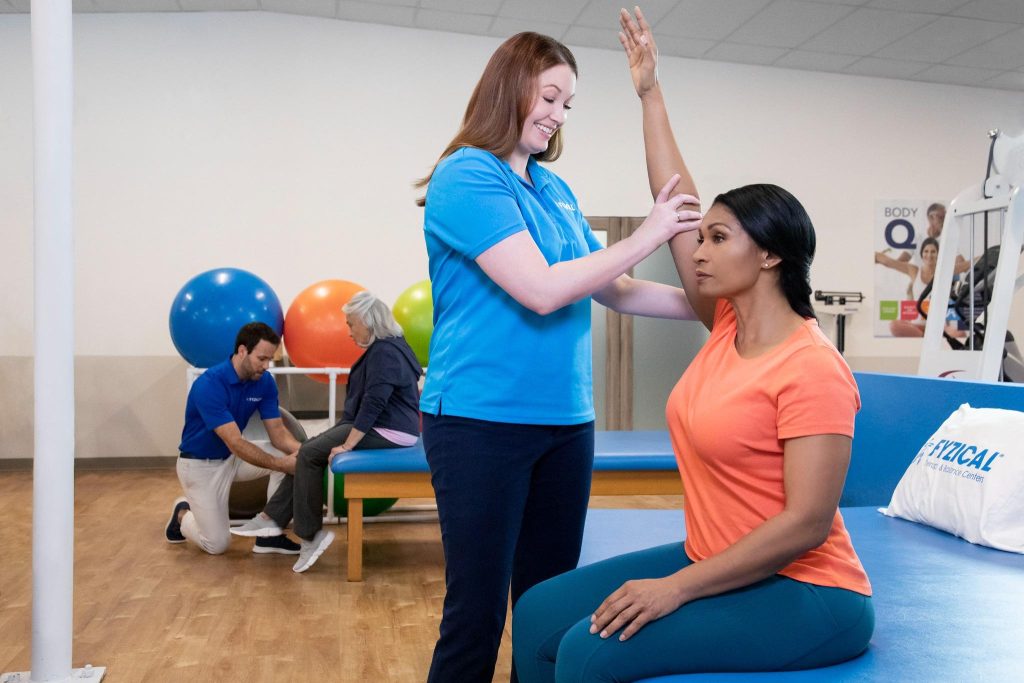Recovering from a rotator cuff injury can be challenging, but physical therapy is essential for restoring shoulder strength and mobility. Whether you’re an athlete or an older adult, rotator cuff injuries are common and often painful. The rotator cuff—a group of muscles and tendons surrounding the shoulder joint—plays a crucial role in stabilizing the shoulder. When injured, it can severely limit your arm movement and affect your quality of life.
In this guide, we’ll explore the importance of physical therapy for rotator cuff repair, and how a customized treatment plan can help you regain full shoulder function efficiently and safely.

Understanding Rotator Cuff Injuries
Rotator cuff injuries may result from:
- Overuse (e.g., sports like tennis or baseball)
- Heavy lifting with poor technique
- Falls or sudden trauma
- Age-related wear and tear
Common Symptoms:
- Sharp or dull shoulder pain
- Weakness in lifting or rotating the arm
- Limited range of motion
- Swelling or tenderness
- Clicking or popping sounds
Prompt treatment is vital to avoid further damage and regain full mobility.
Benefits of Physical Therapy
Physical therapy after rotator cuff repair provides several key benefits:
- Pain relief using stretches, modalities (ice, heat, ultrasound), and manual therapy
- Improved flexibility through guided stretching and mobility exercises
- Strength restoration with tailored strengthening programs for the surrounding muscles
- Better shoulder function, allowing a safer and quicker return to daily activities
Initial Assessment
A personalized recovery plan begins with a comprehensive assessment.
Physical Examination
- Observation of swelling, bruising, and range of motion
- Strength testing and shoulder function evaluation
- Palpation to identify areas of pain and tension
Diagnostic Tests
Depending on the case, imaging may be needed:
- X-rays – show bone structure and any fractures
- MRI scans – provide details of tendon and muscle damage
- Ultrasound – real-time imaging of soft tissue injuries
These results help the therapist craft a precise and effective plan.
Creating a Personalized Treatment Plan
Recovery goals vary by individual, but a strong plan includes:
- Clear milestones (e.g., reducing pain, increasing motion)
- Realistic progression to ensure safe healing
- Custom exercises tailored to your stage of recovery
Key Components:
- Begin with gentle movements
- Gradually increase difficulty with light weights or resistance bands
- Avoid pain-provoking activities
- Stay consistent—regular practice leads to better outcomes
Early Stage Rehabilitation
Initial therapy focuses on:
- Gentle mobility exercises (arm swings, side-to-side movements)
- Reducing stiffness and inflammation with ice and rest
- Controlling pain using doctor-approved medications and massage
- Avoiding overuse—let the shoulder heal before progressing
These steps build a foundation for the strengthening phase.
Strengthening Exercises
As healing progresses, therapy includes:
- Resistance band exercises like lateral raises and shoulder presses
- Controlled movements to prevent re-injury
- Functional training to mimic daily tasks (lifting, reaching, dressing)
Each session builds shoulder stability, muscle coordination, and confidence in movement.
Advanced Recovery Techniques
Manual Therapy
Physical therapists use hands-on techniques to:
- Improve joint mobility
- Release soft tissue restrictions
- Reduce pain and stiffness
Hydrotherapy
- Warm water immersion helps relax muscles and increase circulation
- Water buoyancy supports the shoulder, allowing easier movement
- Especially helpful for patients struggling with land-based exercises
These advanced options accelerate healing and restore function.
Preventing Future Injuries
Technique and Form
- Always warm up before activity
- Use proper lifting techniques
- Maintain controlled movements
- Stop activity at the first sign of pain
Maintenance Routine
- Regular stretching to improve flexibility
- Resistance training to maintain shoulder strength
- Include exercises in your daily routine for long-term shoulder health
- Prioritize rest and recovery—overtraining can lead to setbacks
⚠️ Ignoring proper form or pushing through pain increases the risk of re-injury.
When to Seek Professional Help
See a healthcare professional if you experience:
- Persistent pain beyond a few days
- Swelling or bruising that doesn’t improve
- Difficulty lifting or moving your arm
- Numbness, tingling, or weakness
- Sharp or shooting pains in the shoulder or down the arm
Early evaluation by a physical therapist or orthopedic specialist can prevent complications and speed up your recovery.
Frequently Asked Questions
How soon should you start physical therapy after rotator cuff surgery?
Generally, within 4 to 6 weeks post-surgery. However, your surgeon will guide the timeline based on the severity and type of repair.
What kind of physical therapy is done for rotator cuff surgery?
Treatment includes range-of-motion exercises, stretching, and strengthening tailored to each patient’s recovery stage.
How much physical therapy is needed after rotator cuff surgery?
Typically 12 to 16 weeks of consistent physical therapy are recommended. Duration may vary based on individual progress.
What are the worst things to do after rotator cuff surgery?
Avoid:
- Lifting heavy objects
- Overhead activities
- Skipping physical therapy sessions
- Sleeping on the affected side
- Ignoring pain or pushing through discomfort
Conclusion
Physical therapy is essential for successful rotator cuff repair. It helps reduce pain, restore strength, and improve mobility. With personalized care and dedication, you can regain full shoulder function and return to your normal activities. Stay consistent, listen to your body, and always follow your therapist’s advice.💪 A strong recovery starts with the right therapy plan.